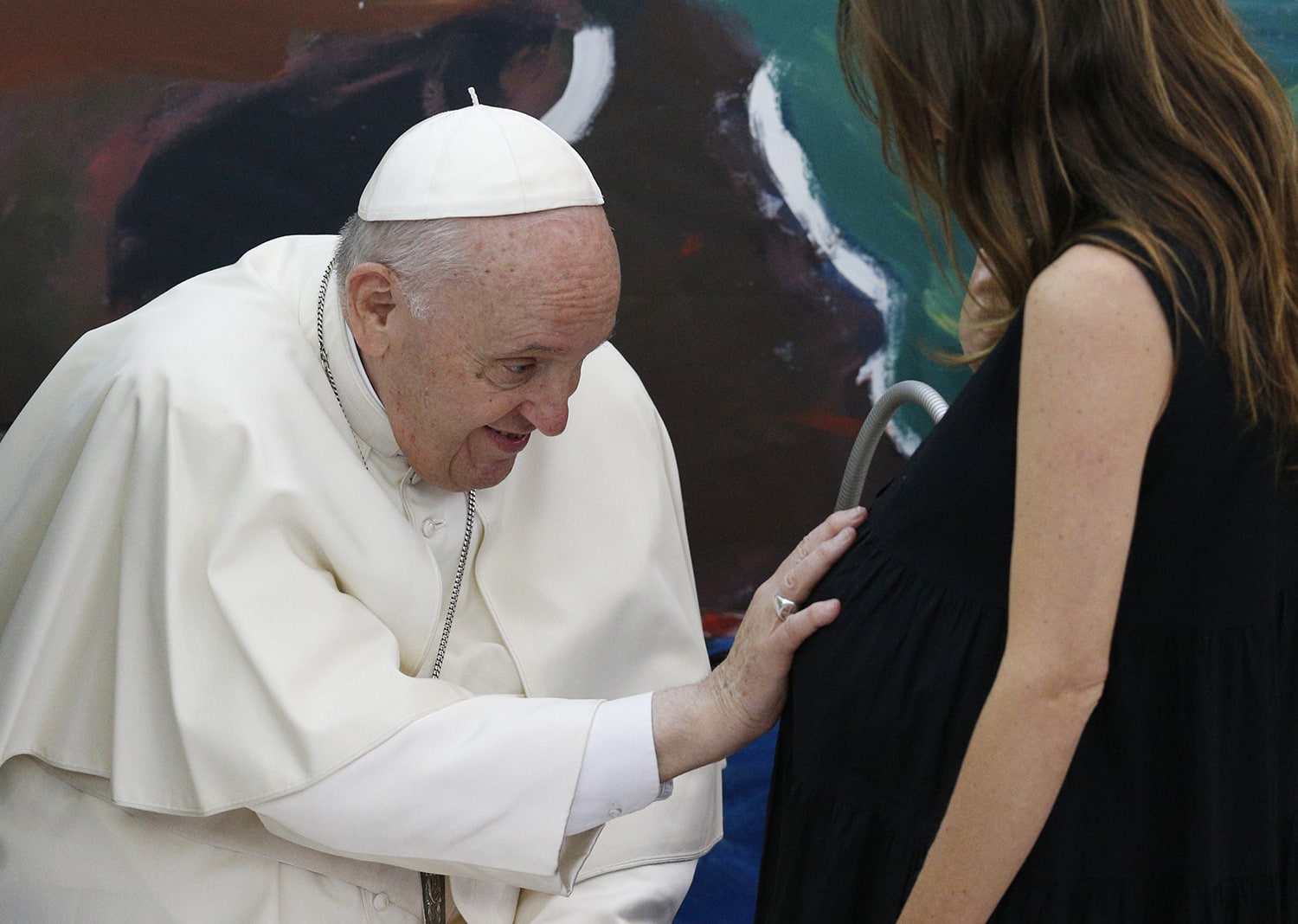(OSV News) — “The gift of life which God the Creator and Father has entrusted to man calls him to appreciate the inestimable value of what he has been given and to take responsibility for it.”
So begins the 1987 document from the Congregation for the Doctrine of the Faith known as Donum Vitae — “The Gift of Life” — on the Church’s respect for human life and the dignity of procreation, replying to bioethical questions raised by emerging conception practices. It noted that this idea — life as a gift — is the fundamental principle upon which moral questions related to procreation pivot.
Donum Vitae is a document that, nearly 40 years ago, made explicit the Church’s teaching about in vitro fertilization and related practices, including gestational surrogacy — a teaching that in January 2024 made headlines after Pope Francis called for a worldwide ban on surrogacy while speaking with members of the diplomatic corps assigned to the Holy See.
“The path to peace calls for respect for life, for every human life, starting with the life of the unborn child in the mother’s womb, which cannot be suppressed or turned into an object of trafficking,” he said at the beginning of his address specifically to ambassadors. “In this regard, I deem deplorable the practice of so-called surrogate motherhood, which represents a grave violation of the dignity of the woman and the child, based on the exploitation of situations of the mother’s material needs. A child is always a gift and never the basis of a commercial contract.
“Consequently,” he continued, “I express my hope for an effort by the international community to prohibit this practice universally. At every moment of its existence, human life must be preserved and defended; yet I note with regret, especially in the West, the continued spread of a culture of death, which in the name of a false compassion discards children, the elderly and the sick.”
Surrogacy as a money-making industry
“Gestational surrogacy” describes the practice of a woman carrying a child in pregnancy on behalf of another individual or couple through the use of IVF. Gestational surrogacy is reportedly more commonly used than its predecessor “traditional surrogacy,” which relied on artificial insemination, resulting in the “surrogate mother” also being the egg donor, and thus the child’s biological mother, creating greater legal (and psychological) complexity.
In the United States, an estimated 750 babies are born annually via gestational surrogacy, but as an international commercial industry, surrogacy is reportedly experiencing what Forbes magazine described as a “global boom.” Global Market Insights anticipates that it will grow from an estimated value in 2022 of $14 billion to $129 billion within a decade.
Contributing to this rise are celebrities who have publicly used surrogacy for their own children, including Kim Kardashian, Anderson Cooper, Matthew Broderick and Sarah Jessica Parker, and Paris Hilton.
According to one surrogacy website, the United States — where surrogacy may cost $130,000 to $160,000 — “is the ‘gold standard’ destination for surrogacy” for its clinics and “supportive legal framework.” Surrogacy costs less in other countries, such as those in Eastern Europe and South America. However, surrogacy laws vary by country (and, in the U.S., by state), with some having no regulations around the practice.
The early years of IVF
Nine years before the CDF (now the Dicastery for the Doctrine of the Faith) published Donum Vitae — largely in response to the development of IVF — Louise Brown had been hailed as the world’s first “test tube baby,” after being conceived via in vitro fertilization in Britain. Prior to this scientific breakthrough, surrogacy was possible through artificial insemination, requiring the child’s “surrogate mother” to also be his or her biological mother. It also allowed for the possibility of a couple who could not conceive themselves to have a child at least partially genetically related to them.
In April 1986, a Detroit housewife became the first “gestational surrogate” to give birth to a child conceived of another couple’s gametes through IVF and then implanted in her uterus.
It was the second time the surrogate, Shannon Boff, had carried a pregnancy for a New York couple, Elliott and Sandra Rudnitzky.
The first time Boff had served as a surrogate, the child was biologically hers — she was considered the “egg donor” but inseminated with the intended father’s sperm. With that baby, “I had to keep telling myself that this was the couple’s child,” Boff told People magazine in 1987. “This one I knew wasn’t mine. That made it easier.” She was paid $10,000.
Less than three weeks before Boff gave birth, another surrogate, Mary Beth Whitehead, gave birth in New Jersey to “Baby M.” As a “traditional” surrogate, Whitehead was the child’s biological mother. After giving birth, Whitehead threatened suicide if the baby’s parents, William and Elizabeth Stern, didn’t give her more time with the newborn. They permitted her to take the baby for one week. Instead of relinquishing the infant, Whitehead and her husband absconded with the baby to Florida. With both the Sterns and the Whiteheads claiming parental rights, the case went all the way to the New Jersey Supreme Court. The Sterns ultimately were granted custody, but the case challenged the legality of surrogacy contracts.
While the case was before the New Jersey Supreme Court, the New Jersey Catholic Conference filed in July 1987 an amicus brief that sided with neither couple, but rather expressed concerns about surrogacy as a whole, arguing the practice “promotes the exploitation of women and infertile couples and the dehumanization of babies.”
”In short, it traffics (sic) for profit in human lives,” the New Jersey bishops said. “What is being paid for is a living child.”
‘Donum Vitae’
Their position reflected Donum Vitae, which had been released in February. However, Noel Keane, the Michigan attorney who brokered both surrogacy contracts, was quoted in The New York Times saying, “I think the church is a little out of touch with the reality of all the Catholic couples who want children to say, ‘You’ve been dealt this hand by God and you’re going to have to live with it.”’
The document, however, makes it clear that its aim is freedom, not limitations, rooted in God’s plan for the human person. Donum Vitae considers specifically the morality of in vitro fertilization, including respect due to the embryo, the procedure’s intervention upon human procreation, and its relationship to civil law.
The instruction affirms that from the moment of fertilization, an embryo is a unique human life and therefore “demands the unconditional respect that is morally due to the human being in his bodily and spiritual totality.” It further notes that the IVF procedure often involves “spare” embryos that are ultimately destroyed. “The connection between in vitro fertilization and the voluntary destruction of human embryos occurs too often,” it states. “This is significant: Through these procedures, with apparently contrary purposes, life and death are subjected to the decision of man, who thus sets himself up as the giver of life and death by decree.”
Donum Vitae completely rejects the use of IVF, even for married couples, explaining that fertilization cannot be separated from the conjugal act, because that act is “inseparably corporal and spiritual.”
Also among considerations in Donum Vitae is the use of surrogacy. It asks the question, “Is ‘surrogate’ motherhood morally licit?” and answers, “No … for it is contrary to the unity of marriage and to the dignity of the procreation of the human person.”
“Surrogate motherhood represents an objective failure to meet the obligations of maternal love, of conjugal fidelity and of responsible motherhood,” it states further. “It offends the dignity and the right of the child to be conceived, carried in the womb, brought into the world and brought up by his own parents; it sets up, to the detriment of families, a division between the physical, psychological and moral elements which constitute those families.”
No ‘right’ to a child
In 2007, 20 years after the publication of Donum Vitae, the CDF revisited the document and new bioethical considerations, especially related to human embryo research, in the instruction Dignitatis Personae. It affirmed that “the teaching of Donum Vitae remains completely valid.
So what of the infertile couple? Does Donum Vitae simply declare that married couples will simply “have to live with it,” as Keane, the Michigan surrogacy attorney, suggested?
No, indeed. Rather, the document suggests that Keane’s kind of criticism is based on a false premise — that a couple has a right to a child, and that “right” usurps the rights of that child.
“The child is not an object to which one has a right, nor can he be considered as an object of ownership: rather, a child is a gift, ‘the supreme gift’ and the most gratuitous gift of marriage, and is a living testimony of the mutual giving of his parents,” Donum Vitae states. “For this reason, the child has the right … to be the fruit of the specific act of the conjugal love of his parents; and he also has the right to be respected as a person from the moment of his conception.”
The document calls for continued medical research to prevent and remedy sterility, and for couples who experience infertility to recognize that it can be “an occasion for other important services to the life of the human person, for example, adoption, various forms of educational work, and assistance to other families and to poor or handicapped children.”

The suffering of infertility
Donum Vitae, however, acknowledges the real suffering that can accompany infertility and calls for the Church to accompany couples who cannot become biological mothers and fathers. The Church’s pastoral documents, especially the 2009 document from the U.S. Conference of Catholic Bishops, “Live-giving Love in an Age of Technology,” expound upon why artificial reproductive technologies “are not morally legitimate ways” to solve the problem of infertility. Rather than turn to ART, the bishops encourage couples not to lose their hope for a child and to pursue medical treatment that could remedy their situation.
As ART has advanced, so has NaProTechnology, developed at the St. Paul VI Institute in Omaha, Nebraska, which aims to identify and treat the medical reasons a couple is experiencing infertility. Meanwhile, the ministries in the Church have also developed to walk with couples enduring this hardship. The U.S. ministry Springs in the Desert, for example, offers multimedia resources, pastoral toolkits for parishes, Zoom-based meet-ups and other events for couples with infertility.
A recent Springs in the Desert blog post rooted infertility within the context of one’s hope of salvation. While acknowledging the deep struggle of waiting to conceive, and wondering if it will ever happen, the author also called for courage, writing, “The key is to realize He (God) gave you this struggle for a reason. It’s not about hopes for a baby or a cure. It’s about hope in God, Heaven, and Him alone as the ultimate source of happiness.”





